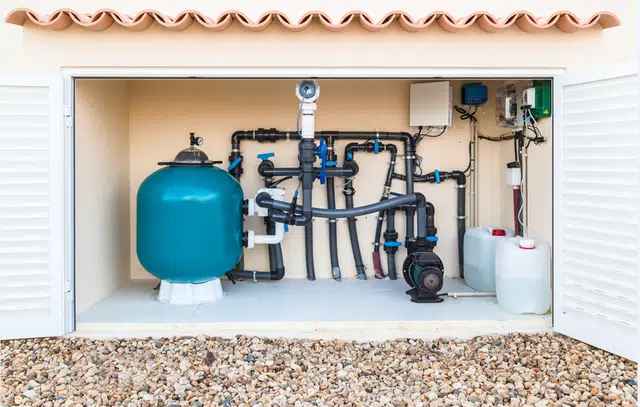
A lot of people in the US own a swimming pool, and despite the COVID-19 pandemic numbers are increasing. However, the quality of those swimming polls is not that great, and in general, most problems lie in plumbing. Because it is easy to build a nice-looking pool from the outside, yet to get the job done inside is a much harder task, which requires much more skill and precision. As a result of not properly done work with plumbing, owners of pools spent a lot of money to fix the damage.
Or, if they do not want to hire somebody, they can try to fix everything with their own hands, but fixing the pool plumbing is not the same as fixing a leaky faucet. To do this job, you must have more knowledge and experience.
Gladly, our article is here to help. We will give you the pool plumbing 101, and after reading it, you will be ready for any problems with your pool.

Before we start to talk about how the pipes should be placed in the pool plumbing system, firstly, we have to say a few words about different types of pipes used in pool plumbing.
Currently, the most popular types of pipes are the following:
Now, let’s elaborate a bit more on each of those types.
Pipes made from copper have been used in plumbing for a very long time. However, now they are almost not used, especially in pool plumbing. Nevertheless, you can still find them in some older pools, for example in old houses. The main disadvantage of copper pipes is the fact that they are much more expensive than PVC pipes. Also they are not so flexible and uneasy about installing, yet they have some prons; for example, copper pipes are more fire-resistant.
PVC is PVC pipes stands for polyvinyl chloride, and pipes made of this material are the most common in pool plumbing nowadays. In general, they do not cost a fortune and are easy to work with. PVC pipes come in different schedules, from 40 to 80; an 80 schedule PVC pipe would be the thicker one, meaning it could serve a longer time. However, it would be harder to work with.
CPVC pipes are very similar to usual PVC pipes, yet they are chlorinated. CPVC pipes are more expensive, but also they work better than the PVC under high temperatures, so, usually in pool plumbing, they are installed in the outlet and inlet ports of pool heaters because they can prevent pipes from shrinking and melting.
Flexible PVC is an upgraded model of a usual PVC pipe with a few adjustments. Flexible PVC is made from the same materials. However, in the production of flexible PVC, plasticizers are used, which makes the pipe more flexible and bendable. This greater flexibility makes the flexible PVC much easier to work with than with the usual PVC. Moreover, flexible PVC can withstand harder temperatures and ground movements.
However, it also has some downsides. First of all, the flexible PVC is not that durable as the usual PVC because it is more prone to earwigs and termites that could make holes in the pipe. Also, flexible PVC can be easily damaged by harsh water.
Plack poly pipes are the last type of pipes on our list. However, they are not the most modern type. Actually, black poly or HDPE pipes were widely used long before PVC pipes became a thing. Moreover, HDPE pipes have all the benefits of PVC pipes, and furthermore, they are not as prone to bugs and have greater chemical resistance than PVC pipes. However, they are more expensive so nowadays they are used very rarely. Also, they perform badly under low temperatures.
Now, you know which types of pipes can be used in the pool plumbing so that you can choose more wisely.
Knowing different types of pipes can be great. However, it is not enough. Because a pool is a much more complex facility that has much more components than usual pipes, which I will describe in this part of the article.
The first pool component that I want to describe is a skimmer. A skimmer can be easily spotted because it is a hole in the inner wall of the pool through which water enters the plumbing system. A pool can have one or several skimmers, which depends on the size of the pool.
From the inside, a skimmer has a net that gathers large trash and debris, like bugs and leaves, and prevents them from entering the plumbing system. Also, some types of skimmers have a door called a floating weir which opens when water pushes on it.
Suction lines can be found after the skimmer. Basically, it is a pipe, one end of which is connected to a skimmer when the second end is connected to the pump.
Now, it is time to talk about the main part of any pool, which is a pump. So, a pump runs water through suction lines to the filters and does a job comparable to the job that heart does in a human body. Without a pump, a pool would not work at all.
So, a pump runs water into the filter, and the filter’s job is to clean the water from the particles that have gone through the skimmer. Some filters can clear water only from hair and small trash, while other, more expensive ones can even stop harmful bacteria.
Now, when water is clean, you want to return it from the filter to the pool, and this can be done with the help of return lines. Like with suction lines, a return line is a usual pipe through which water runs.
Basically, return jets are small holes in the pool through which cleaned water runs back. Usually, return jets are placed around the pool in a way that allows better circulation of water.
Every single pool has to have one main drain on the deep end. If your pool is big enough, you can have several main drains. The main aim of the main drain, as the name implies, is to drain your pool from the water. However, if you decide to drain the pool completely, you have to be very careful because very fast draining of the pool can damage it.
It may seem to be obvious, but a lot of people tend to overlook the water and do not look carefully enough after it. However, the right amount of water is crucially important for the proper functioning of the pool and its plumbing system.
Now, when you know all the parts of the pool, we can talk about how proper plumbing ought to be done.
But first, I have to say a few words about basic theoretical stuff. And as we all know from the school curriculum, the movement of water through the pipes creates friction that slows the water down. Moreover, 90 and 45-degree angles create even more friction and slow water more, so the main issue that you have to avoid constructing the plumbing system of the pool is an abundance of angles.
Because the water in the full regime has to fully circulate every 6 hours, and if it does not, it means that you can have a lot of problems with your pool.
So, finally here are a few tips for you to do plumbing of your pool correctly:
I bring over 9 years of dedicated plumbing experience to the table. As a seasoned professional in the plumbing industry, I've tackled a wide range of projects, from residential repairs to large-scale commercial installations.
